height adjustment Citroen BERLINGO 2014.5 2.G Owner's Manual
[x] Cancel search | Manufacturer: CITROEN, Model Year: 2014.5, Model line: BERLINGO, Model: Citroen BERLINGO 2014.5 2.GPages: 244, PDF Size: 9.96 MB
Page 7 of 244
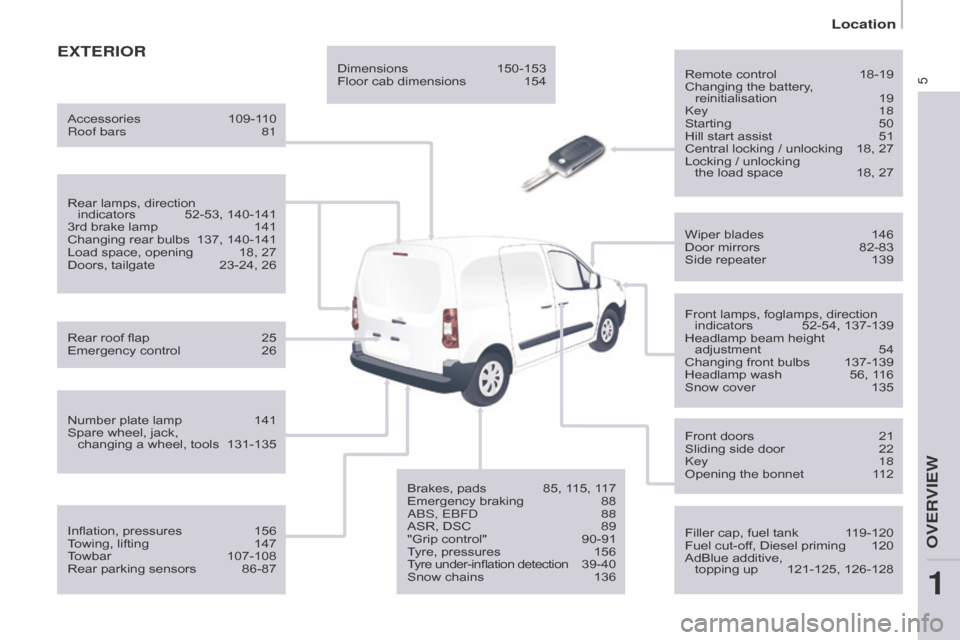
5
EXTERIOR
Remote control 18-19
Changing the battery ,
reinitialisation
19k
ey
18
Starting
50
Hill start assist
51
Central locking / unlocking
18, 27
Locking / unlocking
the load space
18, 27
Filler cap, fuel tank
1
19-120
Fuel cut-off, Diesel priming
120
AdBlue additive,
topping up
121-125, 126-128
Wiper blades
146
Door mirrors
82-83
Side repeater
139
Front lamps, foglamps, direction indicators
52-54, 137-139
Headlamp beam height adjustment
54
Changing front bulbs
137-139
Headlamp wash
56, 1
16
Snow cover
135
Front doors
21
Sliding side door
22k
ey
18
Opening the bonnet
1
12
Inflation, pressures
156
T
owing, lifting
147
T
owbar
107-108
Rear parking sensors
86-87
Number plate lamp
141
Spare wheel, jack,
changing a wheel, tools
131-135
Rear lamps, direction
indicators
52-53, 140-141
3rd brake lamp
141
Changing rear bulbs
137, 140-141
Load space, opening
18, 27
Doors, tailgate
23-24, 26
Accessories
109-1
10
Roof bars
81
Rear roof flap
25
Emergency control
26 Dimensions
150-153
Floor cab dimensions
154
Brakes, pads
85, 1
15, 117
Emergency braking
88ab
S, E
b
F
d
88
ASR, DSC
89
"Grip control"
90-91
T
yre, pressures
156
T
yre under-inflation detection
3
9-40
Snow chains
136
1
OVERVIEW
Location
Page 10 of 244
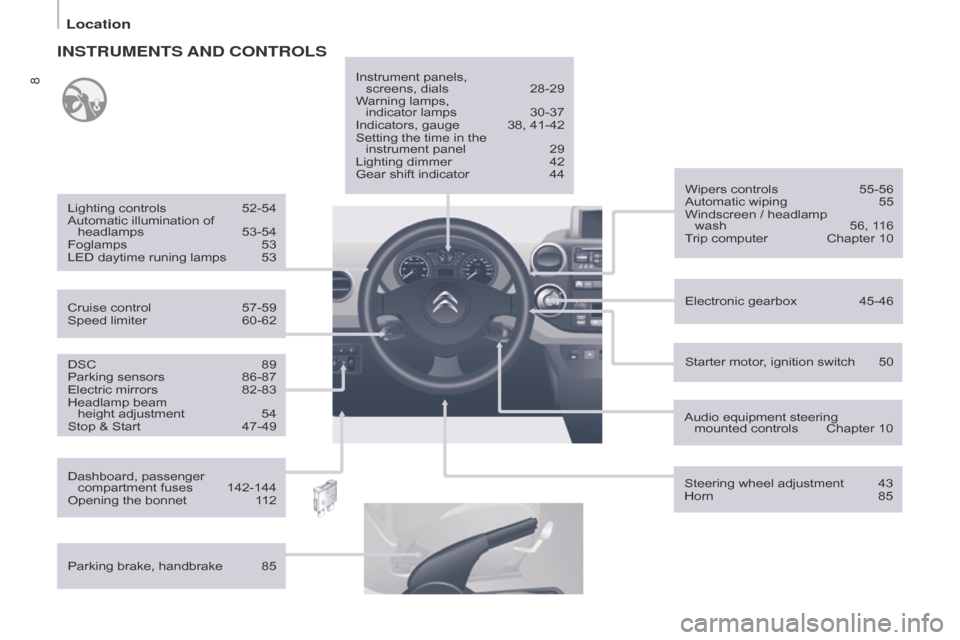
8
DSC 89
Parking sensors 86-87
Electric mirrors
82-83
Headlamp beam
height adjustment
54
Stop & Start
47-49 Starter motor
, ignition switch 50
Wipers controls
55-56
Automatic wiping
55
Windscreen / headlamp
wash
56, 1
16
Trip computer
Chapter 10
Cruise control
57-59
Speed limiter
60-62
Lighting controls
52-54
Automatic illumination of headlamps
53-54
Foglamps
53
LED daytime runing lamps
53
INSTRUMENTS AND CONTROLS
Dashboard, passenger
compartment fuses 142-144
Opening the bonnet
1
12
Parking brake, handbrake
85Instrument panels,
screens, dials
28-29
W
arning lamps,
indicator lamps
30-37
Indicators, gauge
38, 41-42
Setting the time in the
instrument panel
29
Lighting dimmer
42
Gear shift indicator
44
Audio equipment steering mounted controls
Chapter 10
Steering wheel adjustment
43
Horn
85
Electronic gearbox
45-46
Location
Page 12 of 244
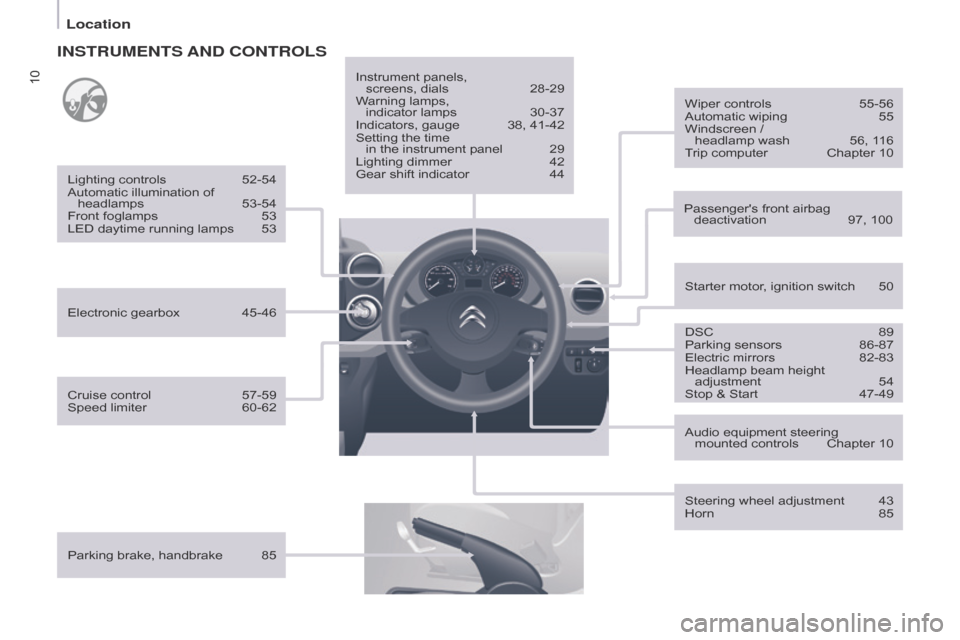
10
INSTRUMENTS AND CONTROLS
Parking brake, handbrake 85Instrument panels,
screens, dials
28-29
W
arning lamps,
indicator lamps
30-37
Indicators, gauge
38, 41-42
Setting the time
in the instrument panel
29
Lighting dimmer
42
Gear shift indicator
44
Passenger's front airbag deactivation
97, 100
DSC
89
Parking sensors
86-87
Electric mirrors
82-83
Headlamp beam height adjustment
54
Stop & Start
47-49
Starter motor
, ignition switch
50
Wiper controls
55-56
Automatic wiping
55
Windscreen /
headlamp wash
56, 1
16
Trip computer
Chapter 10
Audio equipment steering mounted controls
Chapter 10
Steering wheel adjustment
43
Horn
85
Electronic gearbox
45-46
Lighting controls
52-54
Automatic illumination of headlamps
53-54
Front foglamps
53
LED daytime running lamps
53
Cruise control
57-59
Speed limiter
60-62
Location
Page 14 of 244
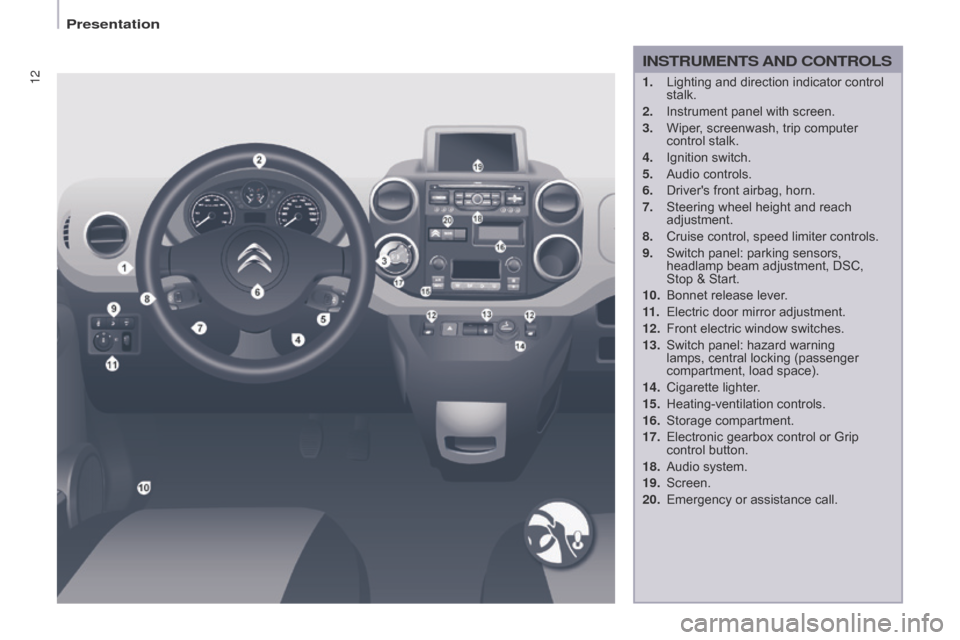
12
INSTRUMENTS AND CONTROLS
1. Lighting and direction indicator control
stalk.
2.
Instrument panel with screen.
3.
Wiper
, screenwash, trip computer
control stalk.
4.
Ignition switch.
5.
Audio controls.
6.
Driver's front airbag, horn.
7.
Steering wheel height and reach
adjustment.
8.
Cruise control, speed limiter controls.
9.
Switch panel: parking sensors,
headlamp beam adjustment, DSC,
Stop
& Start.
10.
Bonnet release lever
.
11 .
Electric door mirror adjustment.
12.
Front electric window switches.
13.
Switch panel: hazard warning
lamps, central locking (passenger
compartment, load space).
14.
Cigarette lighter
.
15.
Heating-ventilation controls.
16.
Storage compartment.
17.
Electronic gearbox control or Grip
control button.
18.
Audio system.
19.
Screen.
20.
Emergency or assistance call.
Presentation
Page 15 of 244
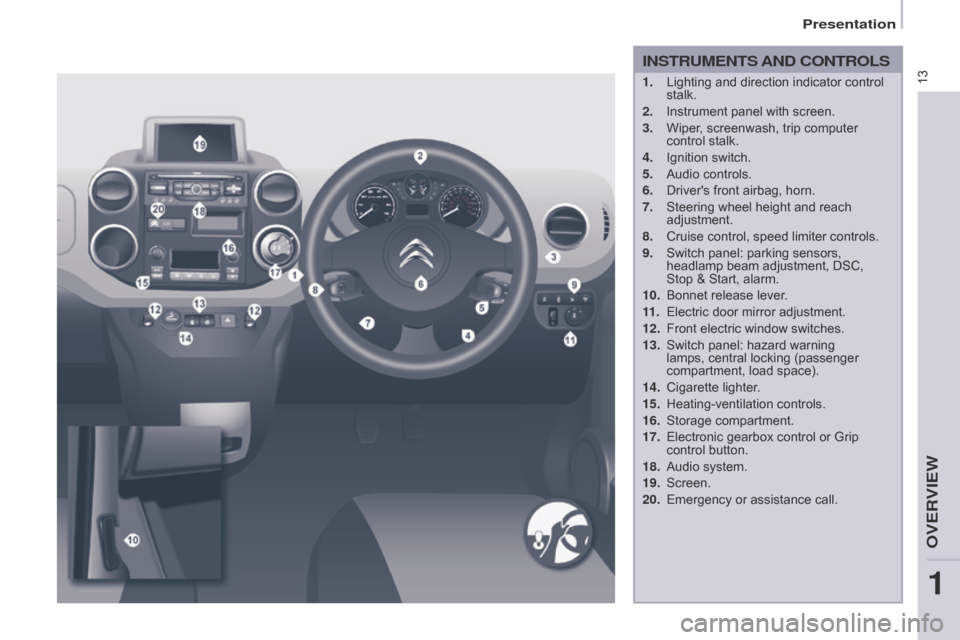
131. Lighting and direction indicator control
stalk.
2.
Instrument panel with screen.
3.
Wiper
, screenwash, trip computer
control stalk.
4.
Ignition switch.
5.
Audio controls.
6.
Driver's front airbag, horn.
7.
Steering wheel height and reach
adjustment.
8.
Cruise control, speed limiter controls.
9.
Switch panel: parking sensors,
headlamp beam adjustment, DSC,
Stop
& Start, alarm.
10.
Bonnet release lever
.
11 .
Electric door mirror adjustment.
12.
Front electric window switches.
13.
Switch panel: hazard warning
lamps, central locking (passenger
compartment, load space).
14.
Cigarette lighter
.
15.
Heating-ventilation controls.
16.
Storage compartment.
17.
Electronic gearbox control or Grip
control button.
18.
Audio system.
19.
Screen.
20.
Emergency or assistance call.
INSTRUMENTS AND CONTROLS
1
OVERVIEW
Presentation
Page 45 of 244
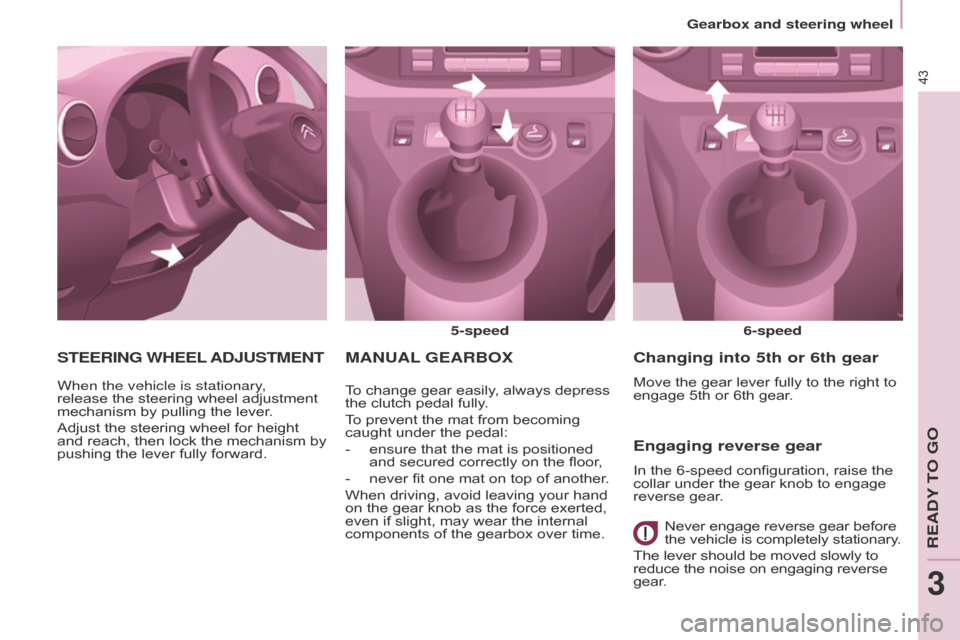
43
Berlingo-2-VU_en_Chap03_Pret-a-partir_ed02-2014
MANUAL GEARBOX
5-speed
6-speed
To change gear easily, always depress
the clutch pedal fully.
To prevent the mat from becoming
caught under the pedal:
-
ensure that the mat is positioned
and secured correctly on the floor
,
-
never fit one mat on top of another
.
When driving, avoid leaving your hand
on the gear knob as the force exerted,
even if slight, may wear the internal
components of the gearbox over time.
Changing into 5th or 6th gear
Move the gear lever fully to the right to
engage 5th or 6th gear.
Engaging reverse gear
In the 6-speed configuration, raise the
collar under the gear knob to engage
reverse gear.
Never engage reverse gear before
the vehicle is completely stationary.
The lever should be moved slowly to
reduce the noise on engaging reverse
gear.
STEERING WHEEL ADJUSTMENT
When the vehicle is stationary,
release the steering wheel adjustment
mechanism by pulling the lever.
Adjust the steering wheel for height
and reach, then lock the mechanism by
pushing the lever fully forward.
Gearbox and steering wheel
READY TO GO
3
Page 71 of 244

69
Berlingo-2-VU_en_Chap04_Ergonomie_ed02-2014
FRONT SEATS
Depending on the version and
configuration of your vehicle, different
front seats are fitted, either:
-
a driver's seat and a passenger's
seat,
-
an individual driver's seat and a
modular bench.
Depending on the models, the
following adjustments are available: 1 - Forwards/backwards adjustment
Lift the bar and slide the seat forwards
or backwards.
3 - Driver's seat height adjustment
T
o raise the seat, pull the handle
upwards then take your weight off the
seat cushion.
To lower the seat, pull the handle
upwards then push on the seat
cushion.
2 - Seat back angle adjustment
With your back pressed against the
seat back, move the lever forward and
set the required angle.
Seats
EASE OF USE and COMFORT
4
Page 72 of 244
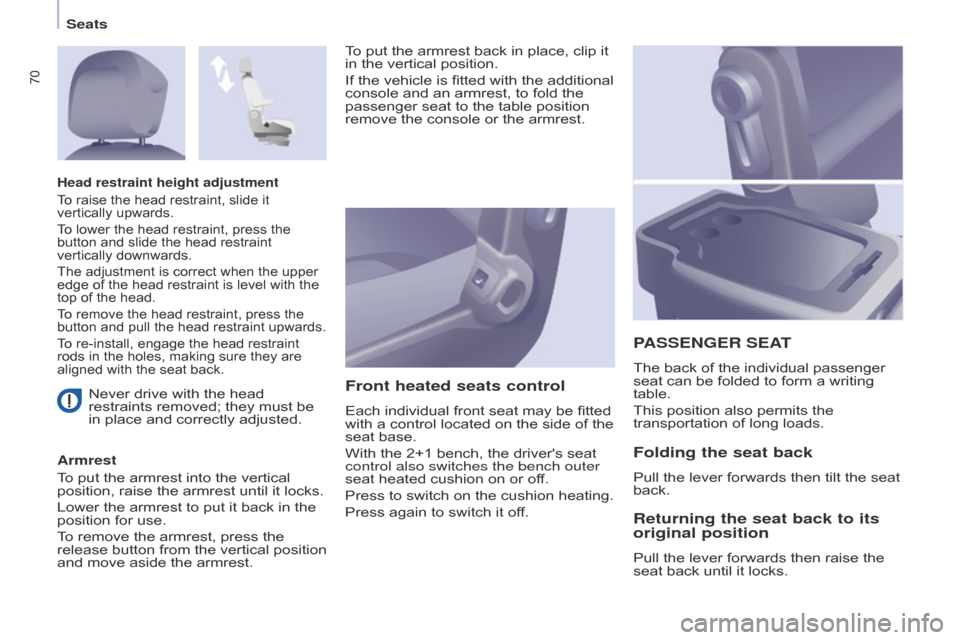
70
Berlingo-2-VU_en_Chap04_Ergonomie_ed02-2014
Never drive with the head
restraints removed; they must be
in place and correctly adjusted.
Armrest
To put the armrest into the vertical
position, raise the armrest until it locks.
Lower the armrest to put it back in the
position for use.
To remove the armrest, press the
release button from the vertical position
and move aside the armrest.Front heated seats control
Each individual front seat may be fitted
with a control located on the side of the
seat base.
With the 2+1 bench, the driver's seat
control also switches the bench outer
seat heated cushion on or off.
Press to switch on the cushion heating.
Press again to switch it off.
PASSENGER SEAT
The back of the individual passenger
seat can be folded to form a writing
table.
This position also permits the
transportation of long loads.
Head restraint height adjustment
To raise the head restraint, slide it
vertically upwards.
To lower the head restraint, press the
button and slide the head restraint
vertically downwards.
The adjustment is correct when the upper
edge of the head restraint is level with the
top of the head.
To remove the head restraint, press the
button and pull the head restraint upwards.
To re-install, engage the head restraint
rods in the holes, making sure they are
aligned with the seat back.
Folding the seat back
Pull the lever forwards then tilt the seat
back.
Returning the seat back to its
original position
Pull the lever forwards then raise the
seat back until it locks.
To put the armrest back in place, clip it
in the vertical position.
If the vehicle is fitted with the additional
console and an armrest, to fold the
passenger seat to the table position
remove the console or the armrest.
Seats
Page 94 of 244
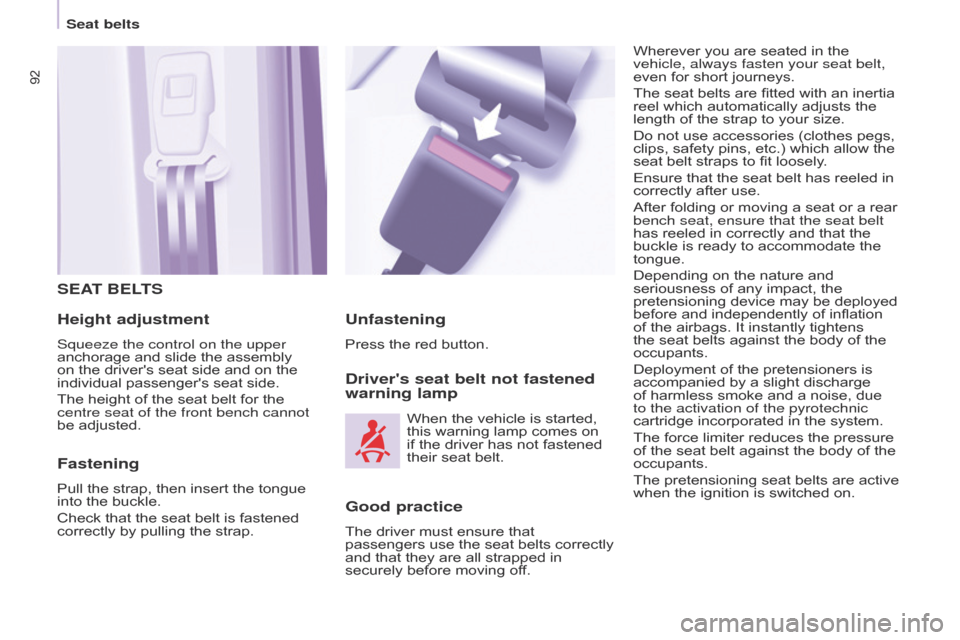
92
Berlingo-2-VU_en_Chap05_Securite_ed02-2014
SEAT BELTS
Height adjustment
Squeeze the control on the upper
anchorage and slide the assembly
on the driver's seat side and on the
individual passenger's seat side.
The height of the seat belt for the
centre seat of the front bench cannot
be adjusted.
Fastening
Pull the strap, then insert the tongue
into the buckle.
Check that the seat belt is fastened
correctly by pulling the strap.
Driver's seat belt not fastened
warning lamp
Wherever you are seated in the
vehicle, always fasten your seat belt,
even for short journeys.
The seat belts are fitted with an inertia
reel which automatically adjusts the
length of the strap to your size.
Do not use accessories (clothes pegs,
clips, safety pins, etc.) which allow the
seat belt straps to fit loosely.
Ensure that the seat belt has reeled in
correctly after use.
After folding or moving a seat or a rear
bench seat, ensure that the seat belt
has reeled in correctly and that the
buckle is ready to accommodate the
tongue.
Depending on the nature and
seriousness of any impact, the
pretensioning device may be deployed
before and independently of inflation
of the airbags. It instantly tightens
the seat belts against the body of the
occupants.
Deployment of the pretensioners is
accompanied by a slight discharge
of harmless smoke and a noise, due
to the activation of the pyrotechnic
cartridge incorporated in the system.
The force limiter reduces the pressure
of the seat belt against the body of the
occupants.
The pretensioning seat belts are active
when the ignition is switched on.
Unfastening
Press the red button.When the vehicle is started,
this warning lamp comes on
if the driver has not fastened
their seat belt.
Good practice
The driver must ensure that
passengers use the seat belts correctly
and that they are all strapped in
securely before moving off.
Seat belts